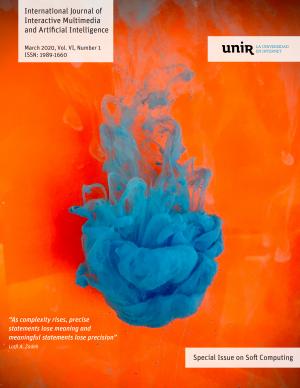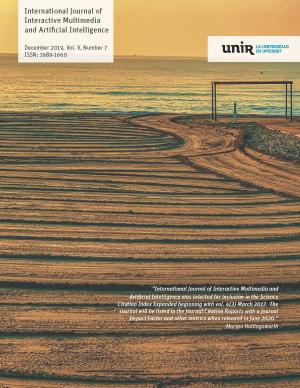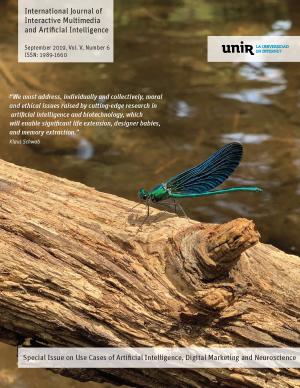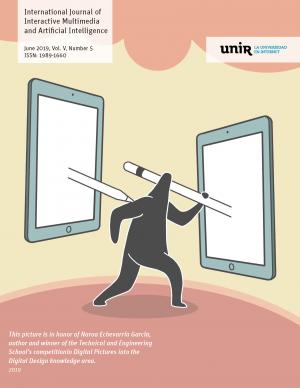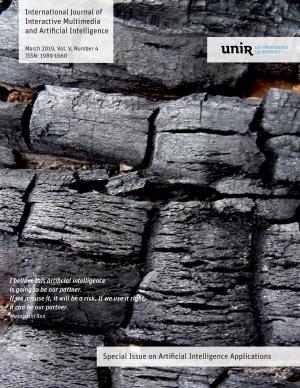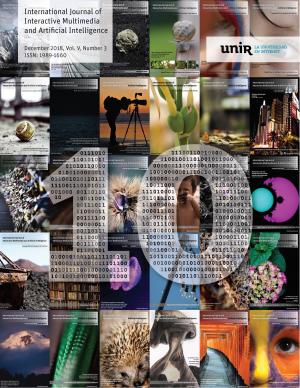This regular issue presents research works based on different AI methods such as deep networks, genetic algorithms or classification trees algorithms. These methods are applied into many and various fields as video surveillance, forgery detection, facial recognition, activity recognition, hand written character recognition, clinical decision, marketing, renewable energy or social networking.
The issue starts with a review article, written by A. Ghazvini, S. N. H. S. Abdullah and M. Ayob, which gives a view on current individual counting approaches based on clustering, detection, regression or density based methods. This regular issue presents research works based on different AI methods such as deep networks, genetic algorithms or classification trees algorithms. These methods are applied into many and various fields as video surveillance, forgery detection, facial recognition, activity recognition, hand written character recognition, clinical decision, marketing, renewable energy or social networking.
The issue starts with a review article, written by A. Ghazvini, S. N. H. S. Abdullah and M. Ayob, which gives a view on current individual counting approaches based on clustering, detection, regression or density based methods. They describe their advantages and limitations, concluding that the use of convolutional neural networks with a density map approach will contribute in scheming more precise counting techniques, focusing not only on counting but also on localization of individuals in crowded scenes.
The second article describes a work of F. López Hernández, L. de- la-Fuente Valentín and I. Sarría Martínez de Mendivil about a quick and simple method to detect brush editing in images, which can be used in image-tampering detection tools. Their two main contributions are: the design of a new approach to detect brush editing and the algorithm of the filter that detects this editing; and the introduction of intentions as subjective metric, in contrast to other classical objective forgery metrics.
N. Bouchra, A. Aouatif, N. Mohammed and H. Nabil investigate deep learning models for face classification tasks. They propose using deep belief networks and stacked auto-encoder besides back propagation neural network to capture various latent facial features. The proposed approach shows better performance on two facial databases compared to other published methods.
A deep learning model is proposed by S. Jha, A. Dey, R. Kumar and V. Kumar-Solanki for visual question answering, a process in which a machine answers to a natural language question related to an image. Specifically the model involves faster Region based Convolutional Neural Network (R-CNN) for extracting image features with an extra fully connected layer whose weights are dynamically obtained by Long Short Time Memory (LSTM) cell according to the question. Questions can be open ended or multiple choice questions and authors show that the visual question answering problem can be solved by a single R-CNN model.
Next work, described by F. Z. Benhacine, B. Atmani and F. Z. Abdelouhab, has the objective of improving the visualization of large sets of association rules to ease doctors’ activity when using clinical decision support systems. The authors propose to use the CASI (Cellular Automata for Symbolic Induction) cellular machine together with the colored 2D matrices to improve the visualization of association rules. Effective interactivity between the human expert and the visualization matrix is a focus of the work to facilitate clinical decision.
In the field of renewable energy, A. H. A. Elkasem, S. Kamel, A. Rashad and F. Jurado aim to allow doubly fed induction generator wind farms (DFIG), which are connected to the power system, to effectively participate in feeding electrical loads. To achieve this they propose a multiobjective optimization algorithm that is applied to a model of doubly fed induction generator wind farm (DFIG) with the aim of determining the optimal values of the gain soft he DFIGcontrol system. The oscillation in power system is one of the problems of the interconnection of wind farms to the grid, and this proposal achieves lower oscillation in electrical power, so that DFIG wind turbines are more reliable.
In the following article, L. E. George and H. A. Hadi propose the use of Electroencephalogram (EEG) signals for user identification and verification processes, which have shown effectiveness against forgery and theft. However, to make EEG applicable, the acquisition process should be easy and a minimum number of mental tasks must be asked to be performed by the user. Specifically, the authors propose methods using only two EEG channels when the user is performing one mental task, in order to reduce system complexity while maintaining high system accuracy.
Next article by S. Taleb Zouggar and A. Adla presents a work on ensemble methods. Although these methods improve the performance of classifiers, they deteriorate the readability of the models. Therefore, some researchers propose to synthesize the structure of a tree from a set of classifiers, but prediction gets worse in this case. S. Taleb Zouggar and A. Adla propose an evaluation function combining performance and diversity for selection in a homogeneous ensemble used in a process of hill climbing. The method was evaluated on several benchmarks and compared to pruning homogeneous ensembles in literature, achieving better results.
In the field of activity recognition, A. Jalal and S. Kamal propose a system that classifies the nature of 3D body postures obtained by Kinect. They present novel features suitable for depth data, which are robust to noise, invariant to translation and scaling, and capable of monitoring fast human body parts movements. Besides, an advanced hidden Markov model is used to recognize different activities. The system outperforms other methods when applied to three depth- based behavior datasets, in both posture classification and behavior recognition.
M. M. G. Ribeiro and A. J. P. Gomes face the challenge of improving visual perception of deutan and protan dichromats, by introducing the first algorithm mainly focused on the enhancement of object contours in images. Typically the problem is mitigated by remapping colors to other colors but this does not help individuals to learn the naturalness of colors from past experience. Their algorithm increases the image contrast while keeping the naturalness of image colors, so the image perception improves but perceptual learning about the world is not disturbed.
Going back to recognition tasks but, this time, of handwritten characters, M. Daldali and A. Souhar propose an Arabic text line segmentation approach using seam carving. The technique offers satisfactory results at extracting handwritten text lines without the need for the binary representation of the document image, even with documents presenting low text-to-background contrast such as degraded historical manuscripts. Although this work focuses on Arabic language, the method is language independent.
Next paper presents another work in the field of medicine, specifically a tool to help radiologists in breast cancer detection tasks. L. Belkhodja and D. Hamdadou describe an automatic computer aided detection system, which combines medical image processing, bioinspired pattern recognition areas and others methods in computer vision. The system succeeded in automatic detection of abnormal regions.
H. M. Keerthi Kumar, B. S. Harish and H. K. Darshan present a work on sentiment analysis. They intend to identify sentiments analyzing short texts, specifically movie reviews. They propose the use of hybrid features obtained by concatenating machine learning features with lexicon features. Experiments show that the results obtained are highly promising both in terms of space complexity and classification accuracy.
Next article by M. Raees and S. Ullah presents an approach on Three Dimensional (3D) interaction inside a Virtual Environment (VE). They describe an interaction technique where manipulation is performed by the perceptive gestures of the two dominant fingers, thumb and index. Experimental results show that the proposed approach has reliable recognition and accuracy rates. Moreover, the system neither needs training of images nor use any feature extraction, hence providing fast preprocessing.
W. Waheeb and R. Ghazali describe a new application of ridge polynomial based neural network models in multivariate time series forecasting. Their main objective is to investigate and compare the forecasting efficiency of neural network models in forecasting the well-known multivariate time series called Box-Jenkins gas furnace time series.
This regular issue starts and ends with review works, specifically the last article is about marketing intelligence and big data. Jan Lies describes how marketing intelligence has started to impact marketing practice with an important scope of social engineering techniques, concluding that marketing intelligence has led to a paradigm shift in marketing, from digital marketing to social engineering. Digital marketing includes data driven marketing, search engine marketing, recommender marketing, etc., while social engineering relates to content marketing, influencer marketing, social media marketing or creative marketing. Marketing intelligence is, without doubt, a current relevant issue. In fact, this is an advance of a next special issue of this journal that will focus on use cases of artificial intelligence, digital marketing and neuroscience.



